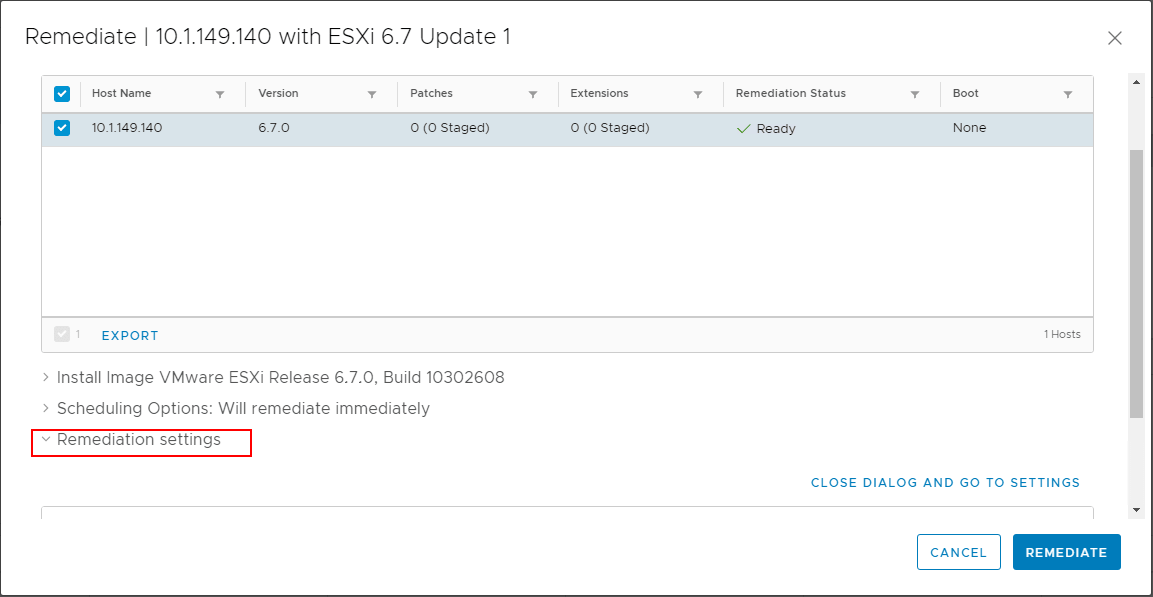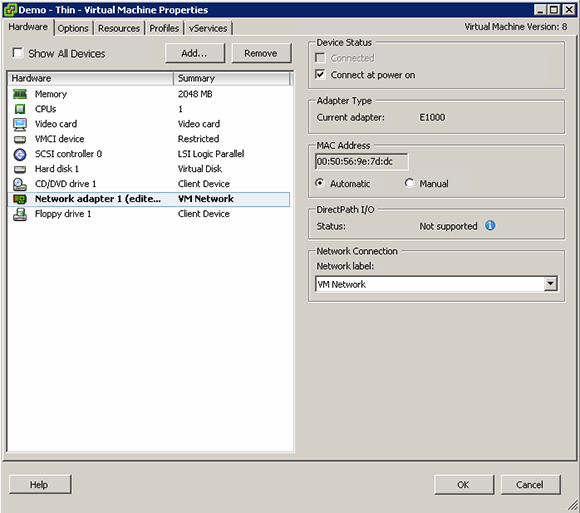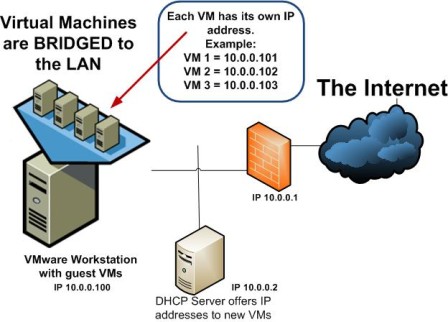- By default, static MAC addresses have the VMware Organizationally Unique Identifier (OUI) as the prefix. However, the range of free address provided by the VMware OUI is restrictions. Assign a Static MAC Address with the vSphere Web Client You can assign static MAC addresses to the virtual NIC of a powered off virtual machine by using the.
- How To Change E1000 into VMXNET3 without changing a MAC Address – The steps. Step 0: Power off your Virtual machine (VM) in the VMWare Console, remote console or web client. Take a note or save the MAC address of the VM.
This method did not work for me at first, then I realized that the server would need to be un-registered from it’s host in VSphere Client or VCS and then after the changes made to the vmx file, the server would need to be re-registered to the same or different host (depending on shared storage config).
When you create a VM on VMware ESXi, each network interface of the VM is assigned a dynamically generated MAC address. If you want to change this default behavior and assign a static MAC address to your VM, here is how to do it.
As you can see above, VMware's vSphere GUI client already has a menu for setting a static MAC address for a VM. However, this GUI-based method only allows you to choose a static MAC address from 00:50:56:xx:xx:xx, which is VMware-reserved MAC address range. If you attempt to set any arbitrary MAC address outside this MAC range, you will fail to launch the VM, and get the following error.
Then what if I want to assign any arbitrary MAC address to a VM?
Automatically Uninstall ScreenConnect Client 6cdc86 (Recommended): This specialized uninstaller can not only help you uninstall ScreenConnect Client 6cdc86 from the computer effectively, but also identify and delete all leftover files, folders and invalid registry entries belonging to ScreenConnect Client 6cdc86. ConnectWise Control supports the use of all iOS devices to support remote guests. Connect to Windows, Mac, or Linux machines. App features include central toolbox, quality settings, reboot and reconnect, manage credentials, chat and much more. ConnectWise Control mobile client can be downloaded free from the iOS App Store. Manual uninstall screenconnect mac pro. Try to uninstall ScreenConnect with the following instruction. How to uninstall ScreenConnect easily and safely? Wise Uninstaller is a powerful uninstall tool which can help you uninstall ScreenConnect within just clicks. Uninstall ScreenConnect completely now! A Better Way to Uninstall ScreenConnect 2.2.1725.4203 with Added Benefits. There is a much easier and safer way to uninstall ScreenConnect 2.2.1725.4203 completely. A third party uninstaller can automatically help you uninstall any unwanted programs and completely remove all of its files and free up your hard disk space.
Page 17 Logging In to Mac OS X Mac OS X is set up to log in automatically using the user account that you Make sure you are typing the user account name and password with created when you set up Mac OS X. If automatic login is turned off, you the same capitalization and punctuation that you used originally. Macbook pro operating system. The first time you turn on your computer, Setup Assistant starts. Setup Assistant helps you enter your Internet and email information and set up a user account on your computer. If you already have a Mac, Setup Assistant can help you automatically transfer files, applications, and other information from your previous Mac to your new MacBook Pro. Apple Macintosh Instruction Manuals (User Guides) As per reader requests, direct links to official Apple Macintosh instruction manuals in PDF format - hosted by Apple's own support site- are provided below as well as on the specs page for each G3 and newer Mac. Not sure which Mac you need to locate?
Fortunately, there is a workaround to this limitation. The solution is, instead of using vSphere GUI client, editing .vmx file of your VM directly, after logging in to the ESXi host.
First, turn off the VM to which you want to assign a static MAC address.
Enable SSH access to your ESXi host if you haven't done it already. Then log in to the ESXi host via SSH.
Move to the directory where your VM's .vmx file is located:
Open .vmx file with a text editor, and add the following fields. Replace the MAC address field with your own.
Now you should be able to launch a VM with the static MAC address you defined in .vmx file.
Subscribe to Ask Xmodulo
Do you want to receive Linux related questions & answers published at Ask Xmodulo? Enter your email address below, and we will deliver our Linux Q&A straight to your email box, for free. Delivery powered by Google Feedburner.

Support Xmodulo
Did you find this tutorial helpful? Then please be generous and support Xmodulo!
Features | Documentation | Knowledge Base | Discussion ForumsMaintaining and Changing the MAC Address of a Virtual Machine
When a virtual machine is powered on, VMware Workstation automatically assigns each of its virtual network adapters an Ethernet MAC address. MAC stands for media access control. A MAC address is the unique address assigned to each Ethernet network device.
The software guarantees that virtual machines are assigned unique MAC addresses within a given host system. In most cases, the virtual machine is assigned the same MAC address every time it is powered on, so long as the virtual machine is not moved (the path and filename for the virtual machine's configuration file must remain the same) and no changes are made to certain settings in the configuration file.
In addition, VMware Workstation does its best, but cannot guarantee, to automatically assign unique MAC addresses for virtual machines running on multiple host systems.
Avoiding MAC Changes
To avoid changes in the MAC address automatically assigned to a virtual machine, you must not move the virtual machine's configuration file. Moving it to a different host computer or even moving it to a different location on the same host computer changes the MAC address.
You also need to be sure not to change certain settings in the virtual machine's configuration files. If you never edit the configuration file by hand and do not remove the virtual Ethernet adapter, these settings remain untouched. If you do edit the configuration file by hand, be sure not to remove or change the following options:
ethernet[n].generatedAddress
ethernet[n].addressType
ethernet[n].generatedAddressOffset
uuid.location
uuid.bios
ethernet[n].present
In these options, [n] is the number of the virtual Ethernet adapter, for example ethernet0.
Note: To preserve a virtual Ethernet adapter's MAC address, you also must be careful not to remove the adapter. If you remove the adapter, then recreate it, the adapter may receive a different MAC address.
Manually Assigning a MAC Address
If you want to guarantee that the same MAC address is assigned to a given virtual machine every time, even if the virtual machine is moved, or if you want to guarantee a unique MAC address for each virtual machine within a networked environment, you can assign the address manually instead of allowing VMware Workstation to assign it automatically.

To assign the same, unique MAC address to any virtual machine manually, use a text editor to remove three lines from the configuration file and add one line. The configuration file has a.vmx extension at the end of the filename. On a Linux host, a virtual machine created with an earlier VMware product may have a configuration file with a .cfg extension.
Remove the three lines that begin with the following from the configuration file:
ethernet[n].generatedAddress
ethernet[n].addressType
ethernet[n].generatedAddressOffset
In these options, [n] is the number of the virtual Ethernet adapter — for example ethernet0.

Mac Address Lookup
Add the following line to the configuration file:
ethernet[n].address = 00:50:56:XX:YY:ZZ
Vmware Find Mac Address
In this line, XX must be a valid hexadecimal number between 00h and 3Fh, and YY and ZZ must be valid hexadecimal numbers between 00h and FFh. Because VMware Workstation virtual machines do not support arbitrary MAC addresses, you must use the above format.
Mac Address Vendor Lookup
So long as you choose a value for XX:YY:ZZ that is unique among your hard-coded addresses (where XX is a valid hexadecimal number between 00h and 3Fh, and YY and ZZ are valid hexadecimal numbers between 00h and FFh), conflicts between the automatically assigned MAC addresses and the manually assigned addresses should never occur.